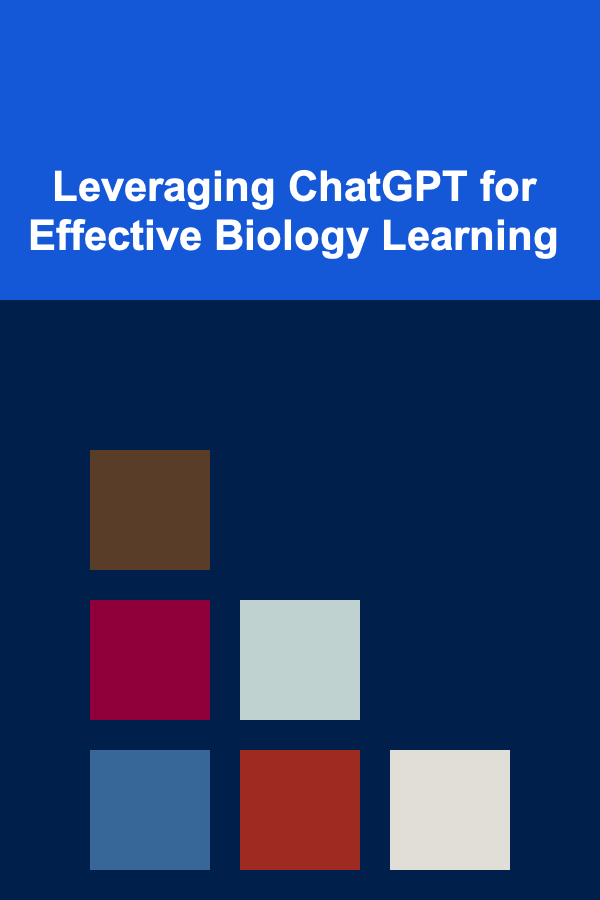
Leveraging ChatGPT for Effective Biology Learning
ebook include PDF & Audio bundle (Micro Guide)
$12.99$8.99
Limited Time Offer! Order within the next:

Biology, the study of life, is a vast and complex field encompassing everything from the intricate mechanisms of cells to the interactions within entire ecosystems. For many students, navigating this intricate web of information can be a daunting task. Traditional learning methods, while valuable, can sometimes fall short in catering to individual learning styles and pacing. Enter ChatGPT, a powerful language model capable of generating human-like text, answering questions, and engaging in interactive conversations. This article explores how you can effectively harness the power of ChatGPT to enhance your biology learning experience, going beyond simple question-answering to foster deeper understanding and critical thinking.
Understanding ChatGPT's Capabilities and Limitations
Before diving into specific applications, it's crucial to understand both ChatGPT's capabilities and its limitations. ChatGPT excels at:
- Information Retrieval and Summarization: It can quickly access and synthesize information from a vast database of text, providing summaries of complex topics and key concepts.
- Explanation and Clarification: It can explain biological processes, define terminology, and clarify confusing concepts in a simplified manner.
- Practice and Testing: It can generate quizzes, flashcards, and practice problems to test your knowledge and identify areas needing improvement.
- Hypothetical Scenarios and Simulations: It can simulate biological scenarios, allowing you to explore the potential outcomes of different conditions or interventions.
- Creative Exploration: It can assist with research paper outlines, brainstorming ideas for projects, and even generating creative content related to biology.
However, it's equally important to be aware of its limitations:
- Accuracy and Verifiability: While generally accurate, ChatGPT's responses are based on patterns in its training data and may occasionally contain errors or inaccuracies. Always verify information with reliable sources like textbooks, scientific journals, or credible websites.
- Lack of Real-World Experience: ChatGPT is a language model and lacks the real-world experience of a scientist or biologist. It cannot perform experiments, analyze data, or provide expert opinions based on personal observation.
- Over-Reliance and Critical Thinking: Over-reliance on ChatGPT can hinder your ability to think critically and develop your own understanding of the material. Use it as a tool to supplement your learning, not as a replacement for independent study and critical analysis.
- Bias: ChatGPT's responses can reflect biases present in its training data. Be aware of this potential bias and critically evaluate the information it provides.
Strategies for Effective Biology Learning with ChatGPT
Now, let's explore specific strategies for leveraging ChatGPT to enhance your biology learning:
1. Mastering Fundamental Concepts
A strong foundation in fundamental concepts is crucial for understanding more advanced topics in biology. ChatGPT can be an invaluable tool for building this foundation.
Example: Understanding Cell Structure
Instead of simply memorizing the parts of a cell, use ChatGPT to actively explore their functions and relationships. Start with a general question:
Explain the structure and function of a eukaryotic cell in detail. Include information about the nucleus, ribosomes, endoplasmic reticulum, Golgi apparatus, lysosomes, mitochondria, and cell membrane.
After receiving an initial explanation, delve deeper by asking follow-up questions:
What is the difference between the rough endoplasmic reticulum and the smooth endoplasmic reticulum? Why are ribosomes found on the rough ER?
How does the Golgi apparatus modify and sort proteins? Give specific examples of protein modifications.
Explain the endosymbiotic theory and how it relates to the origin of mitochondria and chloroplasts. What evidence supports this theory?
By asking specific and targeted questions, you can gain a more nuanced understanding of cell structure and function than you would by simply reading a textbook chapter.
2. Demystifying Complex Processes
Biology is full of complex processes like photosynthesis, cellular respiration, DNA replication, and protein synthesis. ChatGPT can help break down these processes into manageable steps.
Example: Understanding Photosynthesis
Instead of just memorizing the overall equation for photosynthesis, use ChatGPT to understand the individual steps and their significance.
Explain the process of photosynthesis in detail, including the light-dependent and light-independent reactions (Calvin cycle). What are the key inputs and outputs of each stage?
Then, explore the details of each stage:
Explain the role of chlorophyll and other pigments in the light-dependent reactions. How do they capture light energy and convert it into chemical energy?
Explain the Calvin cycle in detail. What is the role of RuBisCO, and how is carbon dioxide fixed? What are the products of the Calvin cycle, and how are they used by the plant?
To test your understanding, ask ChatGPT to explain the process in a different way:
Explain photosynthesis as if you were teaching it to a middle school student.
This forces ChatGPT to simplify the concepts, which can help solidify your own understanding.
3. Visualizing Abstract Concepts
Many biological concepts are abstract and difficult to visualize. While ChatGPT cannot directly create images, it can help you understand the underlying principles and suggest appropriate visualizations.
Example: Understanding the Central Dogma of Molecular Biology
The central dogma describes the flow of genetic information from DNA to RNA to protein. Use ChatGPT to understand the steps involved and their significance.
Explain the central dogma of molecular biology in detail, including the processes of replication, transcription, and translation.
Then, explore the details of each process:
Explain the process of DNA replication, including the roles of DNA polymerase, helicase, and ligase. What is the difference between the leading strand and the lagging strand?
Explain the process of transcription, including the roles of RNA polymerase and different types of RNA (mRNA, tRNA, rRNA). How is mRNA processed before translation?
Explain the process of translation, including the roles of ribosomes, tRNA, and codons. How is the genetic code used to translate mRNA into protein?
To help visualize these processes, ask ChatGPT to suggest helpful diagrams or animations:
Can you suggest some good diagrams or animations that illustrate the processes of DNA replication, transcription, and translation?
You can then search for these resources online to further enhance your understanding.
4. Developing Critical Thinking Skills
Biology is not just about memorizing facts; it's also about thinking critically and solving problems. ChatGPT can help you develop these skills by presenting you with hypothetical scenarios and challenging you to apply your knowledge.
Example: Analyzing Evolutionary Scenarios
Present ChatGPT with a hypothetical evolutionary scenario and ask it to analyze the potential outcomes.
Imagine a population of birds living on an island. The birds eat seeds of varying sizes. A new disease wipes out most of the plants that produce small seeds. How might this event affect the evolution of the bird population over time? What selective pressures would be at play?
ChatGPT can then provide you with a potential explanation based on evolutionary principles like natural selection and adaptation. Critically evaluate the response and consider alternative explanations.
You can also ask ChatGPT to pose hypothetical scenarios:
Give me a hypothetical scenario related to natural selection and adaptation.
Then, try to analyze the scenario yourself before consulting ChatGPT's explanation.
5. Practicing Problem-Solving
Many biology courses involve problem-solving, such as genetics problems or ecological modeling. ChatGPT can help you practice these skills by generating practice problems and providing feedback on your solutions.
Example: Solving Genetics Problems
Ask ChatGPT to generate a genetics problem based on a specific concept, such as Mendelian inheritance or gene linkage.
Create a genetics problem involving a monohybrid cross with complete dominance. Include information about the genotypes and phenotypes of the parents and ask the user to determine the expected genotypes and phenotypes of the offspring.
After attempting to solve the problem, ask ChatGPT to check your answer and provide an explanation of the correct solution.
I think the answer is [your answer]. Is that correct? If not, can you explain the correct solution?
This can provide valuable feedback and help you identify areas where you need to improve your understanding of genetics principles.
6. Preparing for Exams and Assessments
ChatGPT can be a valuable tool for preparing for exams and assessments. It can generate quizzes, flashcards, and practice questions to help you review the material.
Example: Creating a Quiz on Cell Biology
Create a multiple-choice quiz on cell biology, including questions about cell structure, function, and transport. Include at least 10 questions with four answer choices each. Provide the correct answer for each question.
Use the quiz to test your knowledge and identify areas where you need to review the material. You can also ask ChatGPT to generate different types of questions, such as true/false questions or short-answer questions.
Example: Generating Flashcards on Key Terminology
Create a list of 20 flashcard prompts for key terminology in genetics. The prompt should be the term, and the answer should be the definition.
Use the flashcards to memorize key terminology and improve your recall ability.
7. Exploring Specific Areas of Interest
Biology is a vast field, and you may have specific areas of interest that you want to explore in more detail. ChatGPT can help you delve deeper into these areas by providing you with relevant information and resources.
Example: Exploring the Field of Biotechnology
I am interested in learning more about biotechnology. Can you provide an overview of the field and some examples of its applications?
Then, ask follow-up questions about specific areas of biotechnology that interest you, such as genetic engineering, gene therapy, or CRISPR technology.
Explain how CRISPR technology works and its potential applications in medicine and agriculture. What are some of the ethical concerns surrounding CRISPR technology?
ChatGPT can also suggest relevant books, articles, and websites that you can use to further your exploration of the topic.
Crafting Effective Prompts: The Key to Success
The quality of ChatGPT's responses depends heavily on the quality of your prompts. Here are some tips for crafting effective prompts:
- Be Specific: Instead of asking general questions, be specific about what you want to know. For example, instead of asking "Explain photosynthesis," ask "Explain the role of chlorophyll in the light-dependent reactions of photosynthesis."
- Provide Context: Provide ChatGPT with enough context to understand your question. For example, if you are asking about a specific experiment, describe the experimental setup and the variables being investigated.
- Use Clear and Concise Language: Avoid jargon and use clear and concise language that ChatGPT can easily understand.
- Ask Open-Ended Questions: Open-ended questions encourage ChatGPT to provide more detailed and comprehensive responses. For example, instead of asking "Is DNA replication semiconservative?" ask "Explain the process of DNA replication and why it is considered semiconservative."
- Request Examples: Ask for examples to illustrate abstract concepts or processes. For example, "Give me some examples of enzymes and their functions in the human body."
- Specify the Desired Format: If you want ChatGPT to provide information in a specific format, such as a list, a table, or a diagram, specify that in your prompt. For example, "Create a table comparing and contrasting mitosis and meiosis."
- Iterate and Refine: If you are not satisfied with ChatGPT's initial response, try refining your prompt and asking the question in a different way.
Ethical Considerations and Responsible Use
While ChatGPT is a powerful tool for learning, it's important to use it ethically and responsibly. Here are some key considerations:
- Academic Integrity: Do not use ChatGPT to complete assignments or exams that are supposed to be your own work. Using ChatGPT to cheat is unethical and can have serious consequences.
- Plagiarism: Do not copy and paste text from ChatGPT without proper attribution. Always cite your sources, even if you are paraphrasing the information.
- Critical Evaluation: Always critically evaluate the information provided by ChatGPT. Do not blindly accept everything it says as fact. Verify information with reliable sources.
- Personal Learning: Focus on using ChatGPT as a tool to enhance your understanding of the material, not as a shortcut to avoid learning.
Conclusion
ChatGPT is a powerful tool that can significantly enhance your biology learning experience. By understanding its capabilities and limitations, crafting effective prompts, and using it ethically and responsibly, you can leverage ChatGPT to master fundamental concepts, demystify complex processes, develop critical thinking skills, and prepare for exams. Remember, ChatGPT is a tool to supplement your learning, not to replace it. Combine it with traditional learning methods like textbooks, lectures, and lab work to achieve a deeper and more comprehensive understanding of the fascinating world of biology. By embracing this innovative technology, you can unlock new possibilities for learning and exploration in the life sciences.
Reading More From Our Other Websites
- [Soap Making Tip 101] When Ingredients Clash: Navigating Color, Scent, and Texture Challenges in Homemade Soap
- [Home Family Activity 101] How to Create a Cozy Family Reading Nook
- [Tiny Home Living Tip 101] How to Design a Tiny Home with Universal Design Principles for Aging in Place
- [Personal Care Tips 101] How to Apply Makeup Primer for Dry Skin
- [Horseback Riding Tip 101] The Art of Western Dressage: Combining Tradition with Modern Riding Principles
- [Home Rental Property 101] How to Use Social Media to Promote Your Rental Listings
- [Home Party Planning 101] How to Choose the Right Music and Playlist for Your Home Party
- [Home Space Saving 101] How to Maximize the Space Under Your Stairs for Storage
- [Personal Care Tips 101] How to Layer Lip Gloss with Lip Liner for a Defined Look
- [Home Pet Care 101] How to Keep Your Home Safe from Toxic Plants for Pets

How to Choose the Right Playlist for Your Home Party
Read More
How to Use Checklists to Stay on Track with Assignments
Read More
How To Introduce Basic Chemistry Through Simple Experiments
Read More
How To Create Learning Opportunities from Everyday Life
Read More
10 Tips for Writing a Script That Sells
Read More
10 Tips for Planning a Date Night with Kids
Read MoreOther Products

How to Choose the Right Playlist for Your Home Party
Read More
How to Use Checklists to Stay on Track with Assignments
Read More
How To Introduce Basic Chemistry Through Simple Experiments
Read More
How To Create Learning Opportunities from Everyday Life
Read More
10 Tips for Writing a Script That Sells
Read More